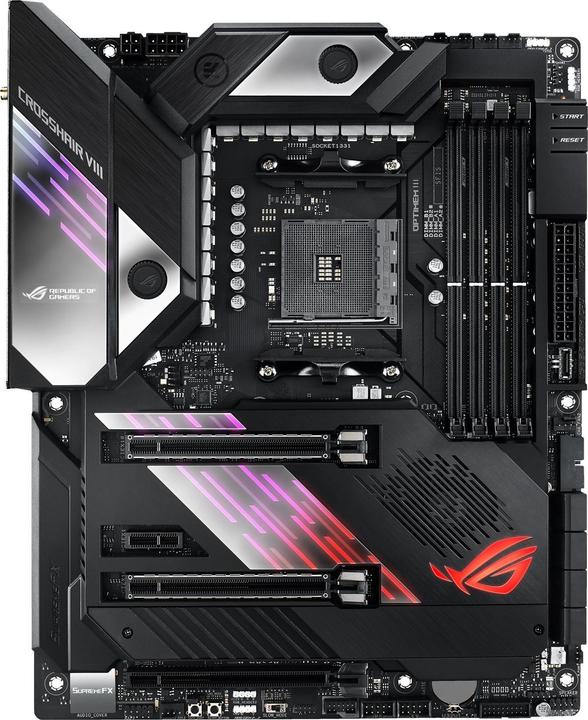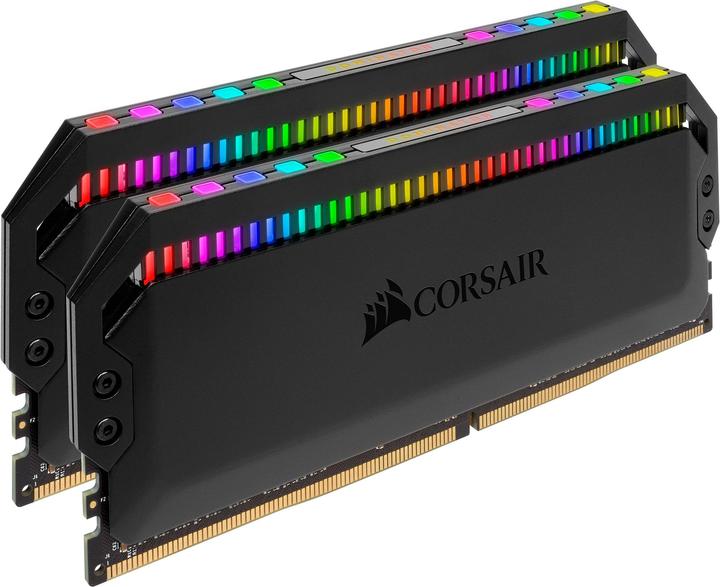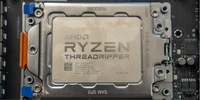
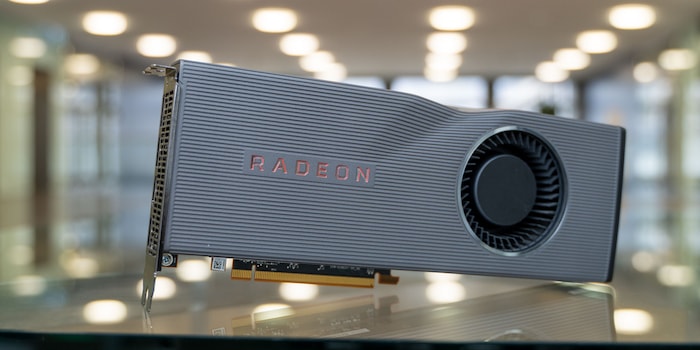
Sapphire Radeon RX 5700 XT tested
The Sapphire Radeon RX 5700 XT kicks off our graphics card reviews. It comes in AMD reference guise, which is why the cooling performance leaves a lot to be desired. In the absence of a basis for comparison, you can expect a lot of figures in this review.
As a reference card, the Sapphire Radeon RX 5700 XT is no different from other reference models - except that it is distributed by Sapphire. The blower fan design that AMD has chosen is not optimal. Some users report that the card heats up very quickly. Let's see how the graphics card performs on our test bench.

The card is tested on our DimasTech Easy V3.0 Benchtable with the following components:
You can read about our graphics card test methodology in the following article:
Facts and features
The Sapphire Radeon RX 5700 XT is manufactured using the 7 nm process and comes with AMD's RDNA architecture. The base clock of the Navi 10 chip is 1605 MHz, the gaming clock is 1755 MHz and the maximum boost is 1905 MHz. The card has 2560 shader units, 160 texture units and 64 raster units.
The 8 GB GDDR6 video memory clocks at an effective 14 GHz and achieves a bandwidth of 448 GB per second thanks to the 256-bit wide memory interface. The power consumption, labelled by AMD as "Total Board Power", is 225 watts. The card is connected to the power supply with an 8-pin and a 6-pin cable. The interface is PCI Express 4.0 x16. One HDMI and three display ports are available as outputs.
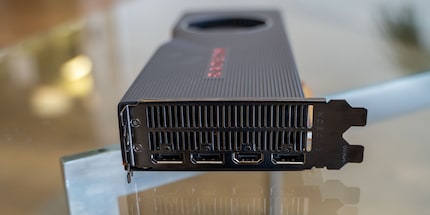
The design of the card is kept simple. The PCB is covered by a dark grey backplate. This and the fan housing are made of an aluminium alloy. The housing is grooved and slightly dented in one place. It looks as if the card has been hit. According to AMD, this shape should ensure better airflow and less noise.
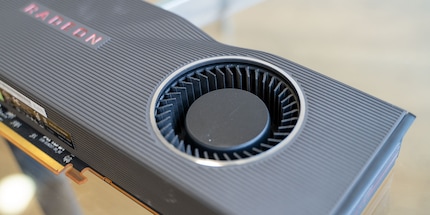
The ambient air is drawn in by the 70 mm centrifugal fan and forced through the fins of an aluminium block in the upper section of the fan housing. The resulting heated air is blown out at the rear of the card - i.e. out of the PC when the card is installed. In contrast to axial fans, this results in more noise, less airflow and higher GPU temperatures. The card is 27.2 centimetres long, 11.1 centimetres wide and 3.6 centimetres high.
Synthetic benchmarks and temperatures
Here are the results of the Time Spy and Fire Strike benchmarks:
| Benchmark | Overall Score | Graphics score
average FPS in Graphics Test 1 and 2 | Combined score
average FPS |
|---|---|---|---|
| Fire Strike
(1080p, DirectX 11) | 22 034 | 25 644
118.59 FPS Test 1 105.21 FPS Test 2 | 9223
42.9 FPS |
| Fire Strike Ultra
(2160p, DirectX 11) | 6042 | 5946
29.82 FPS Test 1 22.82 FPS Test 2 | 2935
13.65 FPS |
| Time Spy
(1440p, DirectX 12) | 9021 | 8767
59.62 FPS Test 1 48.49 FPS Test 2 | n/a |
| Time Spy Extreme
(2160 pixels, DirectX 12) | 4150 | 3900
27.76 FPS Test 1 20.82 FPS Test 2 | n/a |
During the tests, the temperature of the 5700 XT rises up to 83° Celsius. The average during the benchmarks is 80° Celsius. However, the graphics card has not yet throttled. Unfortunately, there is currently no comparative value on our test bench. However, considering that the benchmarks don't run for too long and the graphics card on our test bench can draw in enough ambient air in contrast to a case, I think an average of 80° Celsius is very high. Future comparative tests will show how this should be categorised.
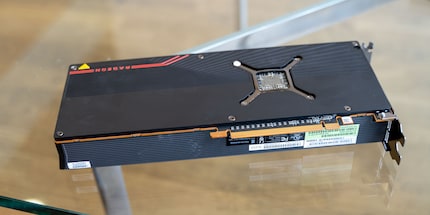
Applications
I ran the benchmarks for the first time. The comparison of graphics cards in Photoshop will be particularly exciting. I have long been interested in the influence of the graphics card on the performance of Photoshop.
Puget Systems Photoshop benchmark
In the Photoshop benchmark from Puget Systems, our testbench is pitted against the following reference workstation:
- Intel Core i9 9900K 8 Core
- NVIDIA GeForce RTX 2080 8GB
- 64GB of RAM
- Samsung 960 Pro 1TB
The configuration of Puget Systems achieves the following values in the tests:
- Overall Score: 1000
- General score: 100
- Filter score: 100
- Photomerge Score: 100
- GPU Score: 100
Our test benchmark with Sapphire Radeon RX 5700 XT achieves the following results:
- Overall Score: 841.4
- General Score: 79.1
- Filter Score: 84.4
- Photomerge Score: 93.7
- GPU Score: 86.5
Puget Systems Premiere Benchmark
In contrast to the Photoshop benchmark, our test benchmark does not compete against a reference workstation. With the Premiere benchmark from Puget Systems, the score is calculated relative to the frame rate of the test videos. If the test video has an FPS of 29.97 and the system renders it at 29.97 FPS, this means 100 points. If it is only 14.98 FPS, there are also only 50 points.
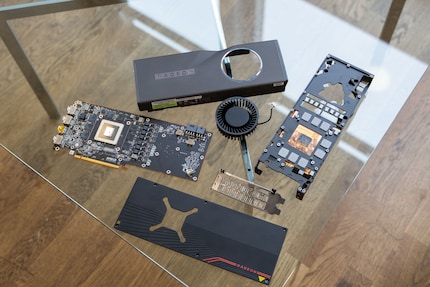
The benchmark runs media in the formats 4K H.264 with 150 Mbps in 8 bit (59.94 FPS), 4K ProRes 422 16 bit (59.94 FPS) and 4K RED (59.94 FPS), testing live playback in Premiere and export. A value of 100 is the maximum for live playback, as Premiere cannot play back the media faster than specified. For export, on the other hand, over 100 points are feasible, as rendering is not limited to the FPS of the media.
In addition, ten ProRes 422 clips are provided with effects that place a heavy load on the graphics card. Puget Systems calls this 4K Heavy GPU Effects. These clips are then also played back and exported in Premiere. The same exists for Heavy CPU Effects, with effects that place a heavy load on the CPU. The GPU value is particularly relevant for the review of the 5700 XT. The CPU values are nevertheless listed for the sake of completeness.
The 5700 XT achieves an average score of 61.3 for live playback and 61.5 for export.
Here are the results in detail:
| Format | Live playback score | Export Score |
|---|---|---|
| 4K H.264 with 150 Mbps in 8 bit (59.94 FPS) | 60 | 91 |
| 4K ProRes 422 16 bit (59.94 FPS) | 100 | 97 |
| 4K RED (59.94 FPS) | 52 | 73 |
| 4K Heavy GPU Effects | 39 | 27 |
| 4K Heavy CPU Effects | 57 | 20 |
Puget Systems after-effects
In the Puget Systems benchmark of After Effects, the benchmark scores are again structured similarly to Photoshop. Our test benchmark competes against the following reference workstation:
- Intel Core i9 9900K
- 128 GB RAM
- NVIDIA GeForce RTX 2080 8GB
The following results are achieved:
- Overall Score: 990
- Render Score: 98.7
- Preview Score: 99.3
- Tracking score: 100.2
Our test benchmark with Sapphire Radeon RX 5700 XT achieves the following results:
- Overall Score: 886
- Render Score: 94.1
- Preview Score: 79.5
- Tracking Score: 92.2
Puget Systems Benchmark Resolve
The scores of the Resolve benchmark from Puget Systems are also based on a reference workstation. To determine the scores, various codecs are rendered in 4K. The reference workstation is based on the following components:
- Intel Core i9 9900K
- A minimum of 32 GB RAM (not mentioned by Puget Systems)
- NVIDIA Titan RTX 24GB
The reference workstation achieves the following results:
- 4K Average Results Overall Score: 1000
- 4K H264 150 Mbps 8 bit Codec Average Score: 100
- 4K Cinema Raw Light: 100
- 4K ProRes 422: 100
- 4K ProRes 4444: 100
- 4K RED: 100
Our test benchmark with Sapphire Radeon RX 5700 XT achieves the following values:
- 4K Average Results Overall Score: 725
- 4K H264 150 Mbps 8 bit Codec Average Score: 70.4
- 4K Cinema Raw Light: 53.4
- 4K ProRes 422: 72.9
- 4K ProRes 4444: 78.4
- 4K RED: 87.6
Blender
The Blender Benchmark renders seven different scenes: Barbershop Interior, BMW27, Classroom, Fishy Cat, Koro, Pavilion Barcelona and Victor. The Sapphire Radeon RX 5700 XT needs 31 minutes and eleven seconds for the seven scenes.
Unfortunately, I cannot provide a reference value for the result, as this is the first graphics card review. In addition, Blender does not yet have any results online.
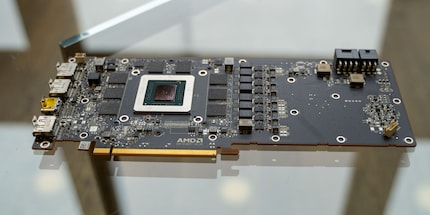
Virtual reality
When it comes to VR, I'm still looking for a programme to test games myself. Unfortunately, Nvidia's FCAT VR doesn't work for us. So here are the results from VRMark and Superposition from Unigine. These benchmarks can be used to find out whether and how well VR gaming is possible on the system in question.
| Benchmark | Score |
|---|---|
| VRMark Orange Room | 11014
Points required: 5000 |
| VRMark Cyan Room | 9026
Points required: 3088 |
| VRMark Blue Room | 2484
Points required: 2972 |
| Superposition VR Maximum
Oculus Rift | 9640
FPS: min. 87.66, avg. 108.45, max. 145.44 |
| Superposition VR Maximum
HTC Vive | 10 000
FPS: min. 96.97, avg. 122.92, max. 174.56 |
| Superposition VR Maximum
HTC Vive Pro | 9591
FPS: min 80.86, avg. 107.9, max. 145.02 |
The games
Last but not least, our four game benchmarks. I'll list the average, minimum and maximum FPS
| Game | FPS 1080p, highest presets | FPS 1440p, highest presets |
|---|---|---|
| "Crysis 3 (DX11) | min. 50.1, average 83, max. 134.9 | min. 25.4, average 38.6, max. 66.6 |
| "Control" (DX11) | min. 25.6, average 55.9, max. 84.1 | min. 28.7, average 37.2, max. 60.9 |
| "Rise of the Tomb Raider" (DX12) | min. 87, average 115, max. 183 | min. 48, average 61, max. 88 |
| "Strange Brigade" (Vulcan) | min. 143, average 184, max. 229 | min. 81.7, average 102, max. 239 |
Conclusion
The Sapphire Radeon RX 5700 XT is a solid mid-range graphics card that runs quite hot due to the cooler design. It delivers the expected results in the applications. Only in Resolve are the results anything but satisfactory. Either it's because AMD needs to make improvements with a driver update.
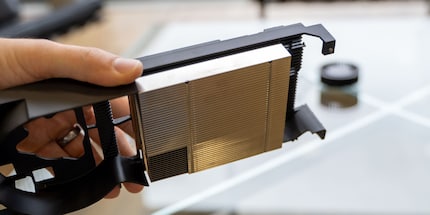
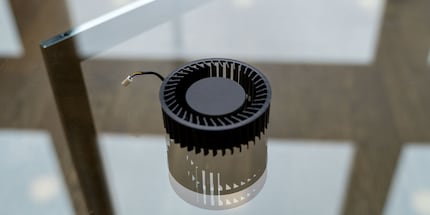
Based on our test results, I would not necessarily recommend the card for gaming in 1440p. The frame rate in "Crysis 3" and "Control" is barely sufficient. The games are playable, but if the frame rate drops below 30 FPS, it's annoying. The two games only run really smoothly if you lower the settings a little. The card is definitely sufficient for current VR games.
Reference cards such as the Sapphire Radeon RX 5700 XT are now available relatively cheaply. If you want to run the card water-cooled, you'll get a good deal. The fastest custom RX 5700 XT at the moment, the Sapphire Radeon RX 5700 XT Nitro+, costs over 100 francs - or 70 euros - more. This is best invested in a cooling block.
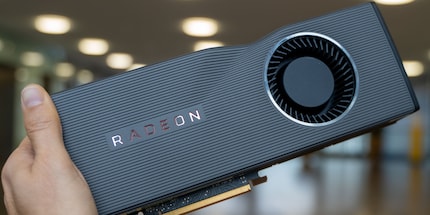
This first graphics card review is relatively short. Future reviews will be a little longer if a basis for comparison is available. If you have any customisation requests, please let me know in the comments column. And if you don't want to miss any reviews, click on the "Follow author" button below.
From big data to big brother, Cyborgs to Sci-Fi. All aspects of technology and society fascinate me.
